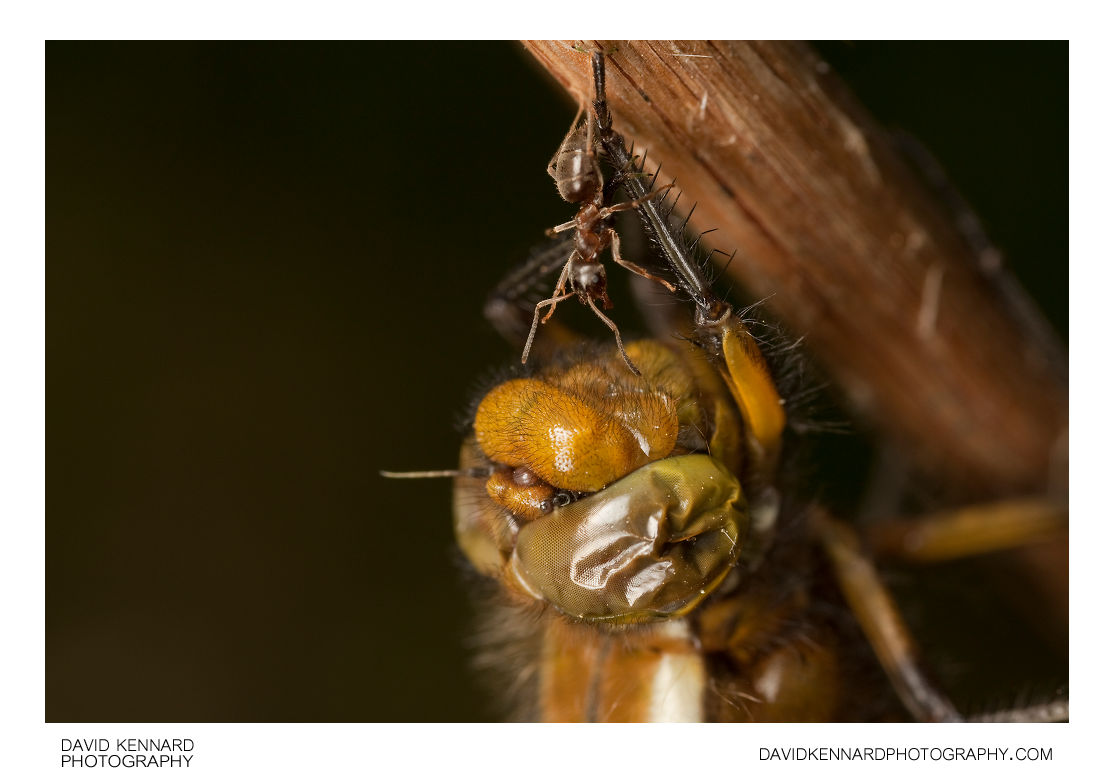Broad-bodied Chaser dragonfly being attacked by ant

Description
- Title:
- Broad-bodied Chaser dragonfly being attacked by ant
- Caption / Description:
-
A common garden ant (Lasius niger) attacks a newly emerged Broad-bodied Chaser dragonfly (Libellula depressa). The dragonfly has badly damaged eyes.
The Broad-bodied Chaser, Libellula depressa, is one of the most common dragonflies in Europe and central Asia. It is very distinctive with a very broad flattened abdomen, 4 wing patches and, in the male, the abdomen becomes pruinose blue.
The male and female have a broad, flattened abdomen which is brown with yellow patches down the sides. In the male the abdomen develops a blue pruinosity which covers the brown colour. Both fore and hind wings have a dark patch at the base. Both the male and female have broad antehumeral stripes. L. depressa is very distinctive and should not be confused with any other dragonflies in the region.
L. depressa is found in central and southern Europe, central Asia and the Middle East. It range extends northwards to southern Scotland, southern Sweden and southern Finland and it occurs on some Mediterranean islands including Corsica, Sardinia, Sicily and Menorca. Its range does not extend beyond southern Europe into Africa.
L. depressa is seen near still-water lakes and ponds, feeding on many types of small insects. They occur in both bare and sunny locations, where it is often the first dragonfly to colonise new habitats such as newly created ponds, and well vegetated ponds. L. depressa are often see away from water as the adults are very mobile and undergo a period of maturation away from water after emergence. The adults are also migratory.
The flight period is from April to September but are mostly seen in May and June. Their flight is very fast as they dart and dive above the water. They are very territorial and will fight with rival males and any other dragonflies they happen to encounter. They characteristically return to a favoured perch, in the sun. When a female enters a male's territory the male will fly up and grab the female. Mating occurs on the wing and the pair are in tandem for only a brief period, often less than a minute. The pair separate and the female will find a suitable location for ovipositing, usually a stretch of open water with submerged vegetation. The female oviposits in flight, hovering above the water and dipping the tip of her abdomen in. The eggs hatch in 4 or 5 weeks and the larvae take one to two years to develop. The larvae live amongst the aquatic vegetation at the bottom of the pond but not buried in mud like some other species of dragonfly. After emergence the adults move away from water and undergo a period of maturation which lasts 10 to 14 days.
This species is usually placed in the genus Libellula but there is some evidence, based on RNA and DNA analysis, that this species should be placed within the genus Ladona. Artiss et al (2001). This change is not yet generally accepted and books and field guides list this species as Libellula
Description taken from Wikipedia: http://en.wikipedia.org/wiki/Libellula_depressa
- Tags / Keywords:
-
- Biota
- Life
- Vitae
- Eukaryota
- Animalia
- Animals
- Arthropoda
- Arthropods
- Insecta
- Insects
- Odonata
- Dragonflies and Damselflies
- Libellulidae
- Common Skimmers
- Libellula
- Libellula depressa
- Broad-bodied Chaser
Admin
- Date Original Photo Taken:
- Original File Name:
- _MG_9560.CR2
- Event:
- Rating:
- Date this image added/last updated on website:
- Original File Dimensions:
- 4272px x 2848px
- File Type:
- JPEG
- Color Mode:
- RGB
- Original Image Color Profile:
- Adobe RGB (1998)
Location
- Location Created:
-
- Sublocation:
- City:
- Market Harborough
- Province/State:
- Leicestershire
- Country:
- United Kingdom
- World Region:
- Europe
- Geo-location:
Rights
- Copyright Status:
- Copyrighted
- Licensing Status:
- Rights Managed
- Available for Editorial Use:
- Yes
- Available for Commercial Use:
- Yes
- Copyright Notice:
- © 2010 Dave Kennard
Camera Data
- Date Digital Resource was created:
- Shutter speed:
- 1⁄200 s
- Aperture:
- f/8
- Camera Model:
- Canon EOS 450D
- ISO:
- 100
- Exposure Compensation:
- 0
- Focal Length:
- 65mm
- Focal Length (35mm equiv.):
- Metering Mode:
- Multi-segment
- Flash:
- On, Fired
- Exposure Mode:
- Manual
- White Balance:
- Manual
- Light Source:
- Exposure Program:
- Manual
Additional shooting metadata
- Lens:
- Canon MP-E 65mm F2.8 1-5x Macro
- Filters used:
- Additional Optics used:
- Setup:
- Handheld
Canon MT-24EX Macro Twin Flash
Post Processing
- Image Modified:
- Software used:
-
- Adobe Camera RAW
- Post Processing:
